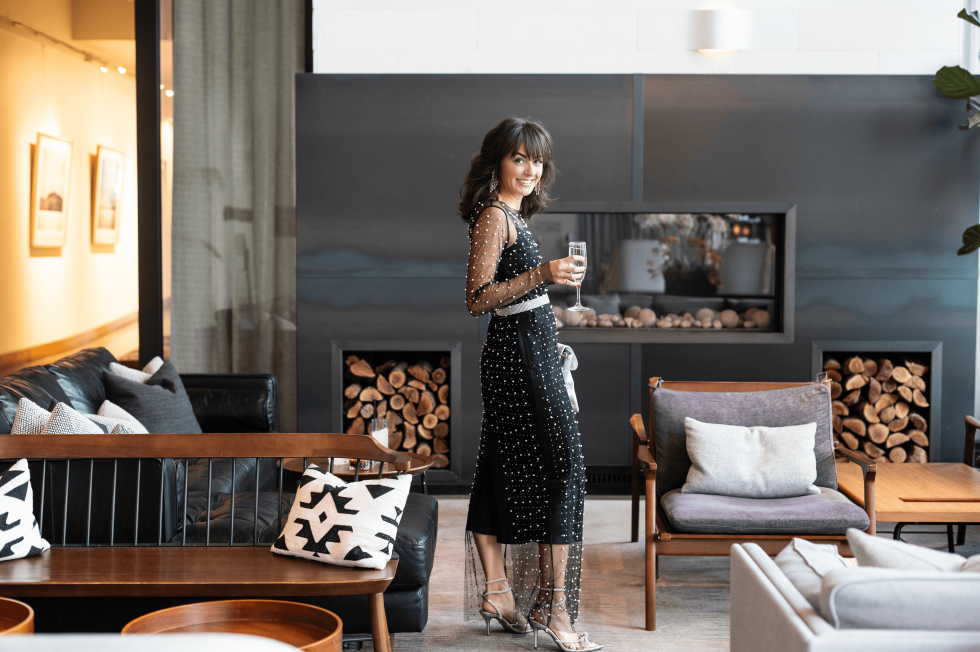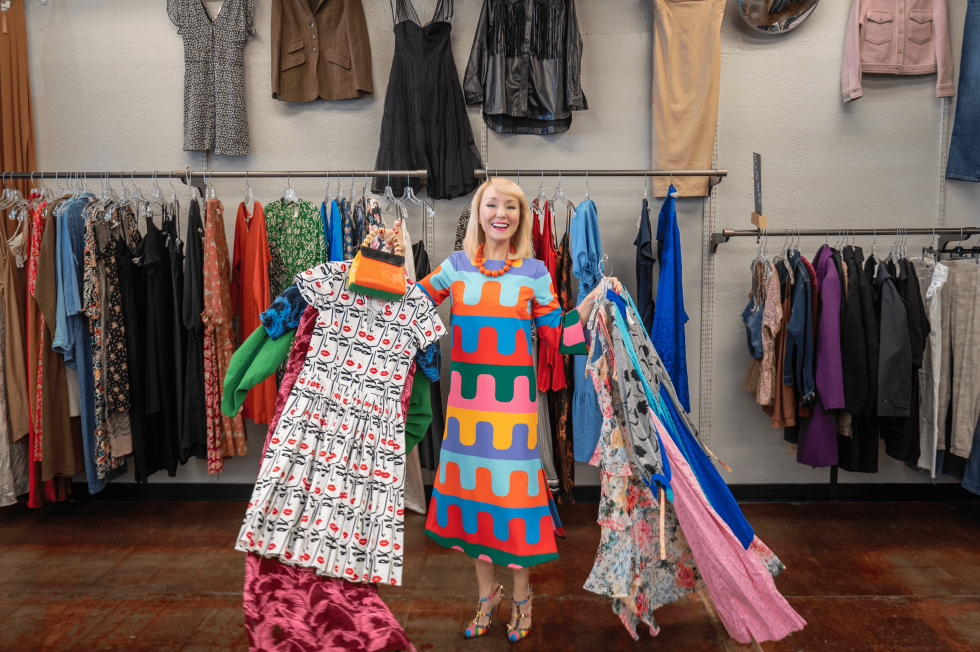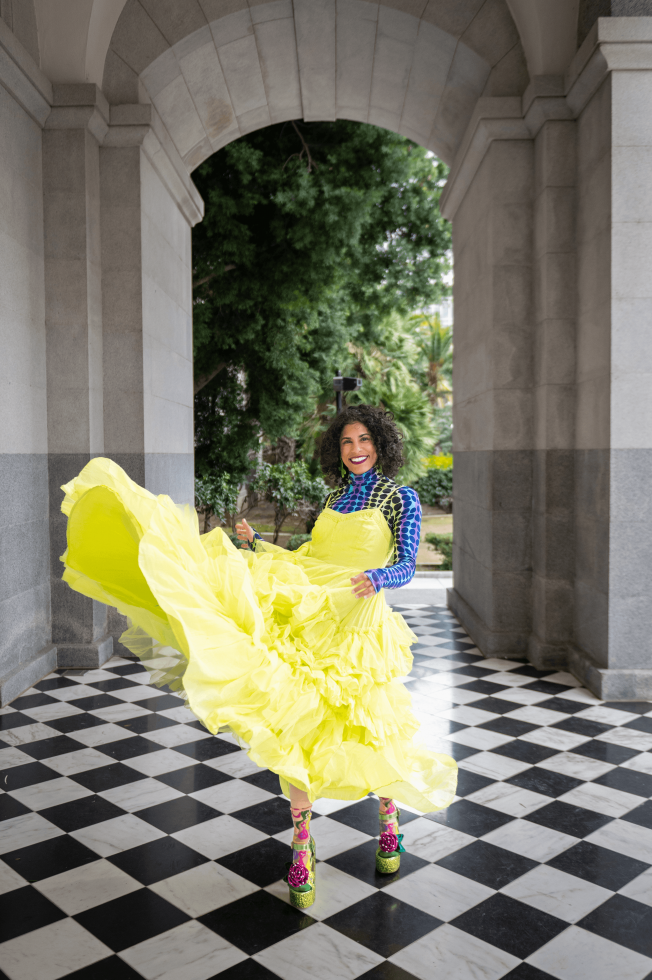Jennifer Sattler was sitting at home wondering what to do next. A Nordstrom stylist for over 20 years, the El Dorado Hills-based professional found herself without a job when the store she was working at closed down at the onset of the pandemic. “Everyone else was like, this is awesome, I’m in my PJs every day,” she shares. “I was the opposite. I missed the interaction and being involved.”
Despite not being tech savvy, Sattler quickly took action. “I didn’t even have a Facebook page,” she laughs. But with so many people at home, she wanted to find a way to connect and help women shop online. She got on Instagram and started posting videos of what she was wearing, calling it her “Haute Mama Look of the Day,” encouraging others to get dressed with her.
Teaming up with fellow Nordstrom stylists across the country, she formed a group called the “Nordstrom 6” to share monthly fashion recommendations. Three years ago she launched Closet Choreography, working with clients to transform their wardrobes through virtual styling, personal shopping and closet detox sessions, and since then has cultivated a community of fashion enthusiasts that span the globe.
Shopping can be overwhelming for many women who may be short on time or resources, have concerns about fast fashion or are frustrated by size discrepancies. Sattler is part of a new wave of local fashion influencers bringing years of practical experience from the fitting rooms to social media to create a unique brand of fashion therapy that recognizes the inextricable link between the clothes we wear and our emotional health.
Closet choreography
Jennifer Sattler, a Nordstrom stylist for over 20 years, now
shares her expertise through Closet Choreography, a blog and
styling service.

For those who are overwhelmed by shopping or just the whole concept of fashion in general, Sattler knows how to break it down and make the experience easier.
A big part of her approach focuses on capsule wardrobes, collections of items she carefully curates using a mix of budget and more expensive pieces — “high/low brands,” she says — that mix and match to create a wide variety of different outfits. “There will always be a few tops, a few bottoms, a layering piece or two, and an accessory or two, but no matter what combination you choose, it will go together,” she says. There are tons of free versions available on her website (just scroll down to find the category link), but more niche versions like her Carryon Capsule Wardrobe — nine pieces that create 49 outfits — can be had for a fee. Subscribers are notified each time a new capsule wardrobe is offered and get a link to a blog post with all the details.
Each capsule wardrobe comes with a checklist that includes different versions of an item to fit a range of styles and budgets. “Whenever I’m sharing a capsule I always share all variations of all items on that checklist so that if you like the ‘60s, modern or retro, you like color, or you only do neutrals, you can find a version of the item that suits you.” You get the checklist, all the links to shop, recommendations, styling tips and tricks, and the look book at the end. “From there the door is open to be able to do what you want with your wardrobe,” she says.
Of course, many are overwhelmed by the wardrobes they already have. In fact, Sattler says most women only wear about 20 percent of what’s in their closets. Her checklist of wardrobe staples keeps clients focused during closet detox sessions so they have a better idea of what to hang on to and what to give away.
A treasure trove of resources, her website and the tips and tricks she offers on social media should inspire anyone who needs help getting a new look together or just doesn’t have the patience to shop for themselves. She’s even developed a jeans quiz for subscribers that takes some of the guesswork out of finding the perfect fit. “I feel good about it because I feel like I’m giving something of value to people for not very much,” she says. “In exchange they shop my links and subscribe to my website, and I have this community of women who are finding their own way and their own style.”
Secondhand magic with the dress fiend
Phoebe Verkouw, aka The Dress Fiend, teaches viewers the ins and
outs of secondhand and vintage shopping on Good Day Sacramento.

Defining your own style is something Phoebe Verkouw, aka The Dress Fiend, knows something about. Each month she teaches viewers the ins and outs of secondhand and vintage shopping on Good Day Sacramento and showcases her eclectic wardrobe on social media, where thrifting enthusiasts on Instagram or TikTok might catch her twirling in vintage finds like a 1970s Valentino suit or ‘90s Betsey Johnson leopard coat. “I got really good at reels during COVID because I was so bored and didn’t have anywhere to wear my clothes,” she laughs. Her mantra? “Be different, be yourself. Wear what brings you joy and have fun in the process!”
More than just a fashionista, Verkouw’s background is a blend of art history, marketing and PR. Passionate about sustainable fashion, she launched her blog, “The Dress Fiend,” while working for the Crocker Museum in 2012. It wasn’t long before Good Day Sacramento invited her on for a segment on secondhand shopping. She pitched the idea of doing it monthly. “Eleven years later I still get to share my love of thrifting,” beams Verkouw. “And teach other people they can do it too!”
That starts with knowing where to go, and Verkouw is a veritable fountain of thrifting knowledge. “You really have to dig, but if you’re low on money, go through the Goodwill Bins,” she says. “I found a stunning vintage silk kimono for $1.65!”
For real designer vintage, she recommends following smaller, charitable thrift stores on social media who often hold that merchandise for special designer day events. Vintage and antique fairs like the Sacramento or Alameda County Antique fairs also offer diverse styles, sizes and decades. But bring a tape measure, she reminds, since vintage sizing is vastly different from contemporary.
Her own education in sustainability started early. “My mom was a seamstress and a tailor,” she explains. “Some of my earliest memories are going thrifting with her at the Salvation Army on 16th, Thrift Town or Crossroads Trading Company.” They didn’t have a lot of money, but she learned the value of giving clothes new life. “We live in a society of fast fashion and a waste culture where we buy things and throw them away,” says Verkouw. “Why not invest in better pieces that you find sustainably and repurpose it too?”
When she’s not advocating sustainable fashion, Verkouw uses her platform as a space to talk about recovery. Recently celebrating five years sober, she’s spent the last few years sitting alongside doctors, alcohol and drug counselors as part of UC Davis’s Substance Abuse Committee, sharing her story about addiction and how UC Davis ER doctors saved her life.
“When I drank I’d end up at the ER. I was probably there 20 or 25 times,” she shares. “Addiction is real and it really plagued me, especially after my mom passed away. But now I get to be an advocate and a voice. It’s one of my great joys to be of service to them.”
Her message is one of empowerment and possibility. “When I worked at Crocker, I was surrounded by millionaires and billionaires,” she shares. “Lots of patrons had money and others didn’t. But guess what? They all respected and loved my thrifted outfits. So that was an ah-ha moment. So that’s what I want to relay to the world, that if I can do it, you can do it too. It’s not off limits to anyone.”
A fashion rebellion with Thalia Castro-Vega
Thalia Castro-Vega, also known by their social media handle
@Polychrom3, embraces a bold, playful approach to a style called
maximalism.

Traditions and cultural trends often dictate what’s considered appropriate for different occasions and professionals in the workplace. But stylist Thalia Castro-Vega, also known by their social media handle @Polychrom3, tosses those rules out the window by embracing a bold, playful approach to a style called maximalism.
Often mixing bold colors, patterns and textures with creative layering, maximalism can be a path to healing your inner child by dressing the way you’ve always wanted to dress. So break out that princess dress or sparkly tights you’ve been too shy to wear out. “Maximalism is really about embracing all parts of yourself and freeing yourself from any societal rules and expectations when it comes to fashion,” says Castro-Vega. “It’s a beautiful thing!”
The Florida native has been working with clients since 2020, guiding them through virtual closet audit sessions and personal shopping that focuses on sustainable and secondhand. “The most sustainable thing you can do is wear the clothes you already have,” advises Castro-Vega. “It’s really about changing your mindset.”
That shift in perspective is a big part of what she helps clients through during closet audits, they say. It’s common for people to have tons of clothes but not really know what to do with them. “Oftentimes when people are stuck in wearing 20 percent of their wardrobes it’s because they’ve restricted themselves mentally based on expectations that we place on others in our society,” they say. Castro-Vega helps deconstruct that thinking so clients can be more open to trying various combinations. “There are also people that like neutrals and they just want to dress in “extra” ways, and I show them how they can do that just by focusing on texture and maybe piecing together some patterns.”
Maximalism was in Castro-Vega’s DNA from day one, they share. “Growing up, I was always very ‘extra.’ … But we didn’t grow up with a lot of income, so most of my experiences shopping as a child were clearance racks at Marshall’s for $2 or $3 clothing.” But that didn’t stop them from making the most of what they had. “When I looked at my peers’ clothing and I looked at the stuff I would pick off the clearance racks, mine always looked cooler in my head!” they laugh.
Their “GRWM” (Get Ready With Me) videos on social media often show them dressing for everyday occasions like trips to the grocery store in outfits bursting with vivid hues, bold, colorful patterns and textures in unique combinations: everything from tulle skirts to checkered jeans, vintage corsets, fuzzy floral sweaters and layered “summer goth” looks all in black. “For me when I look at clothing, it’s like looking at paintbrushes and my body is the canvas, or someone else is the canvas. It’s a form of art for me.”
They share advice about how to pull together maximalist looks as well as powerful messages about confidence and being your authentic self. Clothing is like a second skin, says Castro-Vega, and can be a powerful reflection of our identity and emotions.
“I think it’s important to empower yourself not only mentally but with how you dress,” they say. With over 300,000 followers collectively on Instagram and TikTok, it’s a unique approach to mindfulness that appears to be resonating. “I got a message from one woman who was excited to be wearing more pink,” they share. “I think seeing someone be so free in their style makes other people want that too.”
Castro-Vega wants people to know they don’t have to change who they are in order to succeed in the professional sphere. “I used to think I had to fit myself into that box, and then one day I decided I just didn’t care,” shares Castro-Vega. In the years since they’ve seen plenty of tears flow as clients make the same realization. “For the first time in their lives they’re being told they can do things they somehow thought they couldn’t. They’re being given permission for the first time when it comes to fashion. And I think that’s beautiful.”
Stay up to date on business in the Capital Region: Subscribe to the Comstock’s newsletter today.
Recommended For You

Mud, Music and the Man
A Sacramento Burner shares thoughts on the community spirit of this year’s rainy Burning Man
While reporters and commentators struggled to understand why
73,000 would choose to isolate — and unintentionally strand —
themselves in the desert, Burners lived out the experiment Black
Rock City was built for.

Sacramento’s Sol Blume Music Fest Is Back in the Sun
A rescheduled Sol Blume sets new attendance record
After torrential rains hit the Capital Region early in 2023, flooding out Discovery Park, organizers of the upcoming Sol Blume festival planned there for April 29-30 had some decisions to make.



